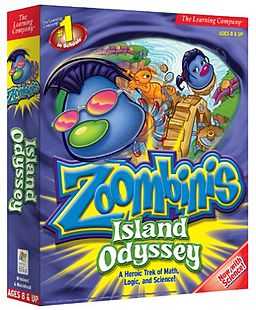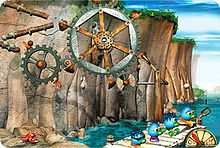Zoombinis Island Odyssey
| Zoombinis Island Odyssey | |
|---|---|
 | |
| Developer(s) | The Learning Company |
| Publisher(s) | The Learning Company Feral Interactive (Mac OS X) |
| Engine | Proprietary/Custom |
| Platform(s) | Microsoft Windows, OS X |
| Release date(s) |
|
| Genre(s) | Educational, puzzle |
| Mode(s) | Single-player |
| Distribution | CD-ROM |
Zoombinis Island Odyssey is an educational puzzle computer game developed and published by The Learning Company in 2002. It was published for the Mac OS X by Feral Interactive the following year. It came after Zoombinis Mountain Rescue, which was launched on October 25, 2001.
Summary
In this game, the Zoombinis discover that they left the native moths to die in their former homeland of Zoombini Isle, and return to the Isle, which is now empty of the colonist Bloats who earlier enslaved the Zoombinis. A group of 12 Zoombinis, which can be customize, are each carrying a caterpillar in order to restore the island life. The player must then complete different puzzles, such as growing berries and breeding butterflies, to eventually restore the ecosystem of the island. This is the first game of the series to incorporate science in the puzzles, which include intersection of rates, decoding, astronomical time, Venn diagrams, and Punnett squares, as well as some reincarnations of puzzles from Logical Journey. The graphics have again changed, and the Zoombinis' features are no longer important to gameplay. Here, they are fully 3-D. When the Zoombinis release 224 Zerbles (native wildlife) into the wild, the Zoombinis return to Zoombiniville, and the game is won.
Zoombinis
Before the player starts their journey they are able to customize their 12 Zoombinis by designing the way they look. Note: This does not affect gameplay
- Hair: Shaggy hair, a ponytail, flattop hair, small tuft, and bob hair with a cap
- Eyes: Wide eyes, one eye, sleepy eyes, glasses, and sunglasses
- Noses: Green, yellow, red, violet (purple), and blue
- Feet: Shoes, roller skates, a spring, two wheels, and propellers
Puzzles

The Wheel
The first puzzle in the game is a mixture of timing and pattern finding. A large wheel turns round in a circle that can be stopped at any time and two sets of balls are selected to fill in the cups that are attached to the ends of the spokes on the wheel. The balls are made of rock or mud and the player must get the timing and order correct so that the rock ball hits the launch pad that the Zoombini is standing on. If all mud hits the launch pad, nothing will happen. As the difficulty increases, more wheels are added making the pattern harder to follow.
The Wall
This puzzle challenges the player's logical thinking. The player will have to recognize patterns and be able develop and test their hypothesis. There are hieroglyphs on the wall, and the player will need to put in the corresponding wall piece to win. If a wall piece is put in the wrong spot, bits of stone will fall. The player has limited amount of tries so if this continues, the door will be blocked and the player will have to try again. When a player has to retry the symbol mappings will be different. As difficulty increases, the pattern becomes more complex.
The Planetarium
This puzzle is another logic test, where the player has to match the time on a clock to a picture of the Earth rotating on its axis and a picture of the sun as it is viewed from Earth. The player is able to change the time by inserting coins that will add to time to the corresponding picture. Additionally, the player has to use a point of reference to help them, which is the tree. If the player goes pass the time on the clock, the player will need to try again. The hardest difficulty uses the cycles of the moon instead of the sun.
The Greenhouse
The player has to guide a moth through a field of Snozzleberry plants to pollinate the seedlings. There are two types of moths, which are color moths and type moths. Color moths will only follow specific colors(blue,yellow,orange,red,purple) and type moths will only go through the same type indicated on the moth. The moth be able to travel through its type flower all the way until it hits the seedling. The player will have to do this correctly 12 times in order to proceed. In harder difficulties, there are more colors and types of flowers. In addition, the puzzles get more complex because the player has to swap the position of the plant in order to make a path.
Arno's Garden
Now that the seedlings are pollinated, the Zoombinis have to plant them. There are four holes in the ground and the player has to plant the seedlings. Each plant has four parts which is the root,stem,leaf,and flower. Each plant also has four different colors, which is red,yellow,blue,purple. Arno is very picky about which seedlings go to which hole so the player has to sort the plants by certain color or part type. If the player puts a seedling in a wrong group, it will be rejected. If the player goes over the limited amount of tries, then the garden closes. As difficulty increases, more holes appear.
The Corral
The seedlings's that were planted produced snozzleberry, but the player needs to figure out which fruit to feed the Zerbles. Each Zerble likes to eat a specific Snozzleberrie. Snozzleberries have three characteristics which is their color, leaf shape, and fruit shape. There are projectiles that shows one characteristic and if the Zerble eats that kind it would walk into the light. In the easiest difficulty, there are only two projectiles. Players will need to be able to interpret a Venn diagram. As difficulty increases, there are more projectiles. The puzzle is completed after all Zerbles are fed.
The Barn
Now that the Zerbles are fed, they are ready to be paired in order to produce offspring. There is a spinning wheel that produces a random set of characteristics that the offspring should have. The player will have to choose two Zerbles with the desire characteristics. The player will have to figure out which traits are dominant and which are recessive. This puzzles allows the player to be familiar with the Punnett squares.
System Requirements
Microsoft Windows
- 32-Bit Operating system: Windows 95, Windows 98, Windows 2000, Windows Me, Windows XP, Windows Vista*, Windows 7
- Processor: Intel Pentium 200 MHz or faster
- RAM: 32 MB or more
- Hard disk space: 80 MB or more (not including 7 MB for Adobe Acrobat Reader)
- Video card: 16-bit video card
- Sound card: Windows-compatible sound card
- Audio Device
OS X
- Operating system: Mac OS 8.6 and later, OS X through 10.4 (Tiger) , but not 10.5 (Leopard) which does not support the Classic runtime environment
- Processor: PowerPC 233 MHz or faster
- RAM: 32 MB or more
- Hard disk space: 80 MB or more (not including 7 MB for Adobe Acrobat Reader)
- Video card: 16-bit video card
- Speakers
Awards
- Finalist for the 2003 Codie Award for Best Education Technology Solution for Home/Consumer.
- Won the Parents' Choice Award in Spring 2003
References
http://www.learningvillage.com/html/rZoombinisIO.html
http://www.parents-choice.org/product.cfm?product_id=11479&award=xx